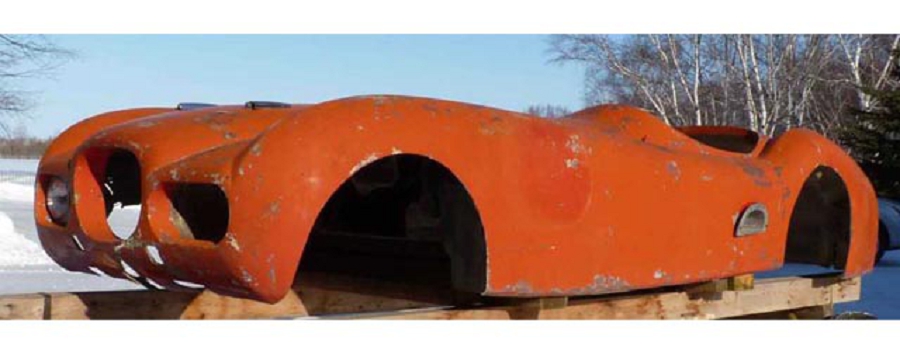
Hi Gang…
About a year ago, I heard from an enthusiast in Manitoba, Canada – Ed A. – who wrote the following:
Geoff, I just found your web site tonight which is quite fascinating. I have a friend here in Manitoba, Canada who has had this fiberglass body since the late 50’s but no one has any idea as to what it is or who designed it. With your knowledge would you be able to tell me if it’s a one off or not. I have attached a number of photos for your information. Thanks for your time. Ed A.
Ed and I chatted for a bit, and I invited him to our next show that included some rare ‘glass cars which then was at the 2013 Milwaukee Masterpiece. And I hadn’t heard anything about the car since – until today when it went up for sale on a Canadian website.
The “for sale” notice was first posted by Jesse and our friends at Barnfinds.com. Click here to review their story, photos, and comments on the car. And thanks, Jesse, for posting this neat car and the information about it on Barn Finds – very nice to promote these mystery cars for all to enjoy and see.
The interesting thing is not that it’s for sale, but…how much attention these mystery cars get from so many engaged car guys out there. Seeing a car you’ve never seen before is a fun and maybe even an exciting experience – especially for veteran car guys who have seen most cars before.
And that’s what makes our niche here at Forgotten Fiberglass more fun for all of us than we can handle at times.
You see, “mystery cars” are not rare if you are into the handcrafted sports cars of the postwar era. The idea that if you wanted to have an American (or in this case perhaps a Canadian) sports car in the late 1940s or 1950s meant…your choice was limited. The Corvette was limited production and didn’t start until ’53. And…foreign sports cars were hard to get, expensive to buy, and complicated to maintain.
Where were the throngs of American (or North American) sports cars???
They were here gang – you just had to build, buy, or create your own from scratch. And this wasn’t as rare as you might think. In fact, I have file after file and photo after photo of cars that were sent to us as “mystery cars” and many that we have already identified based on research from those who contribute to this site on a daily basis.
Rollie Langston, Raffi Minasian, Glenn Brummer, Wayne Graeffen, Harold Pace, Darren Swanson, Alden Jewell, Bob Cunningham, Leon Dixon, Marshall Foxworthy, Erich Schultz, Guy Dirkin, Mitchell Philip, Wally Wallace, John Sulsar, Mark Brinker, Steve Cowdin, Rodney Packwood, Tom Chandler, Frank Cornell, Jon Greuel, John Gulow, Merrill Powell, Pat Amendolio, Jim and Lea Ann Robinson, Bill Warner, Paul Sable, Jim Giles, Chuck Tatum, Denny Allen, David Lambert, Stan Fowler, and more…….all of you and more help in every way to crush the “mystery” of our “mystery car” and reunite the cars with their history and to give them back their “soul.”
So we are honored to help when we can, and sometimes the research takes 2-3 years or more to identify what the cars are and the heritage from which they came. We even have many stories on these cars – a class of cars we call “Mysterions.”
Breaking With Tradition:
Mystery cars have traditionally been written off as something of little or no value – and I understand why. Provenance and heritage is everything in terms of establishing the value and worth of any commodity. And Rick D’Louhy and I stewed on this issue for quite a many years. And then it hit us. With the number of mystery cars we have seen over the years, we really have an opportunity to pay recognition and respect to the class of unknown American postwar designers and builders whose cars survive through today.
And in 2010, our opportunity to put this issue to rest came with Bill Warner’s help at the 2010 Amelia Island Concours d’Elegance. For…it was at this event that we broke new ground. Rick and our team of restorers finished the restoration on a beautiful mysterion that we now call the “Californian.” This was a car that – so far – we have found another fully built car and one un-utilized body. Two cars, one body – no history. But what beautiful cars they are.
So with Bill Warner’s approval (thanks Bill!), we rounded out our class of 9 “Forgotten Fiberglass” cars at the 2010 Amelia Island Concours d’Elegance with the selection of our 1955 Californian (Mysterion) sports car.
* Click here to review a story about this car and the Amelia Island Concours d’Elegance in 2010.
Let’s Head Back Up North To Canada:
Let’s have a look at some photos of this mystery car/body for sale:
So…what do we know about this mystery body in Canada? In the last year, we have not identified it or its heritage in any way. We do not know who made it. We don’t know who designed it. We don’t know how many were made.
But in reality, we know a lot more about the “big picture” that was present when this car was designed. It has lines that are similar to a Glasspar G2 and hence a Jaguar XK120. The construction techniques and the use of the quad headlights (assuming that these wee not a later modification) point to a heritage of about 1955 or so.
Remember..the seller got the car in the 1950s and it was already used – knowing this helps quite a bit. And of course the men who built it….we know a lot of the skills, tenacity, and talent of the men who came out of the World War II era be it American or Canadian – our Greatest Generation.
So it’s not a mystery car to our group in any way. It’s a car needing a few more bullet points of information via a newspaper, relative, or friend, that may still have some information on it and….the puzzle will be nearly complete. It’s a car that can be appreciated in every way for its design and construction techniques. It’s a car that when completed and restored may very well weave its way on a path to a Canadian or American concours d’elegance on its own.
It’s all about the finish and the heritage with any car we appreciate – and this body has an abundance of both.
Summary:
Those of you wanting to see the ad posted on Kijiji, click on this link to take you to this ad. And if you decide to buy the car, we’d be happy to help with our continued research and any advice on how to build this car up – period correct – here at Forgotten Fiberglass.
Hope you enjoyed the story, and until next time…
Glass on gang…
Geoff


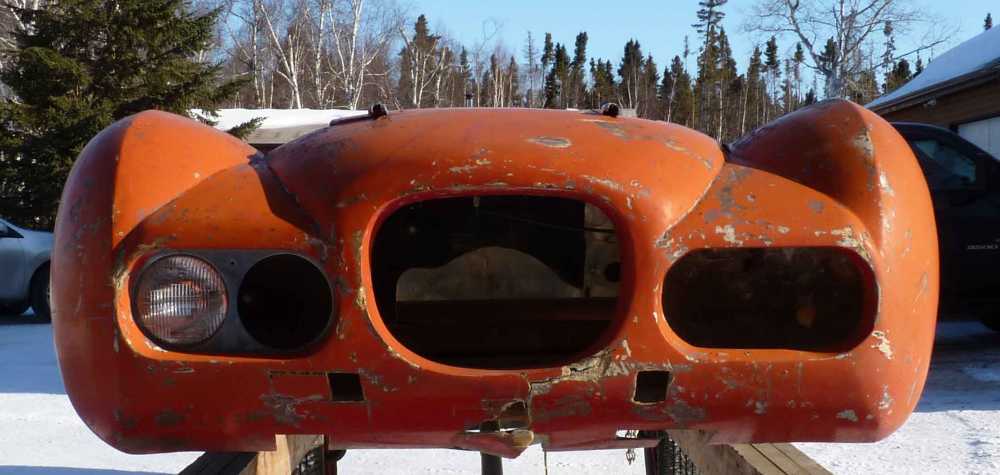
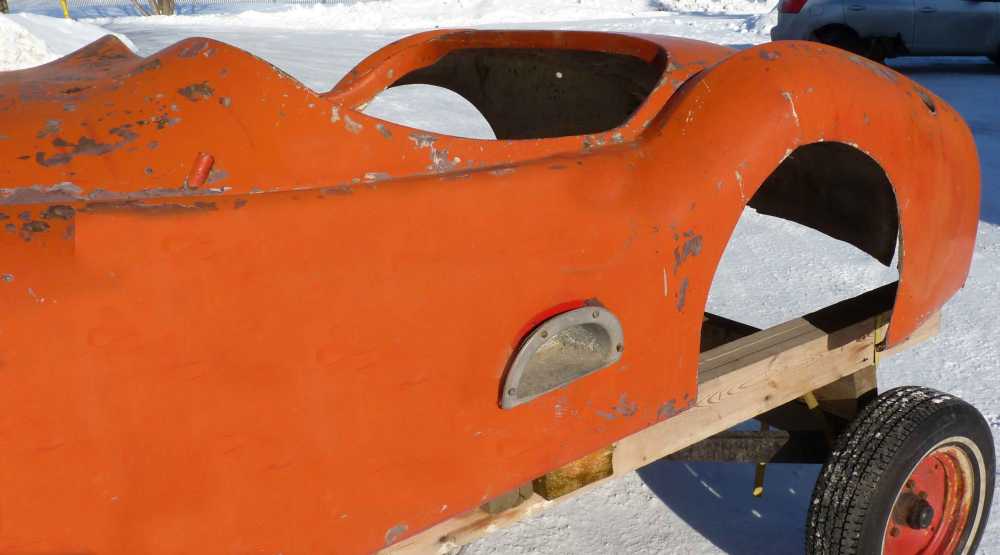
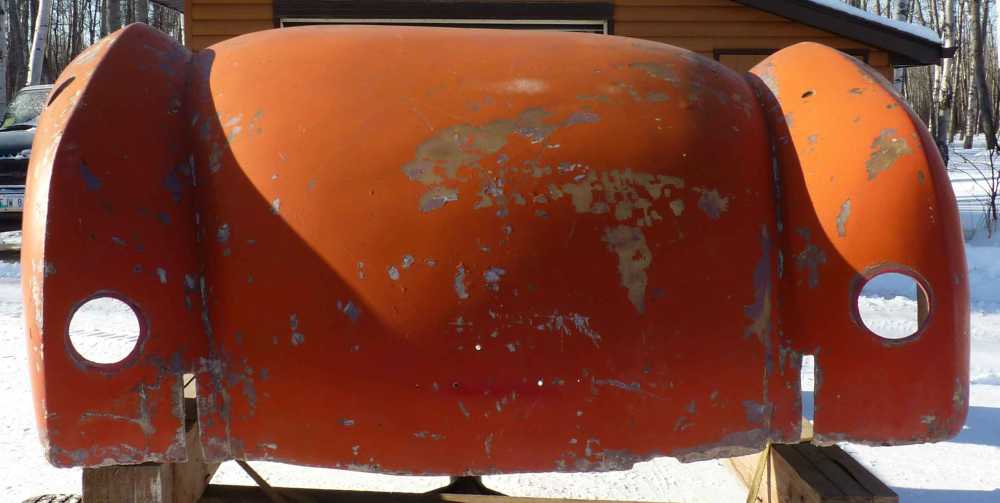
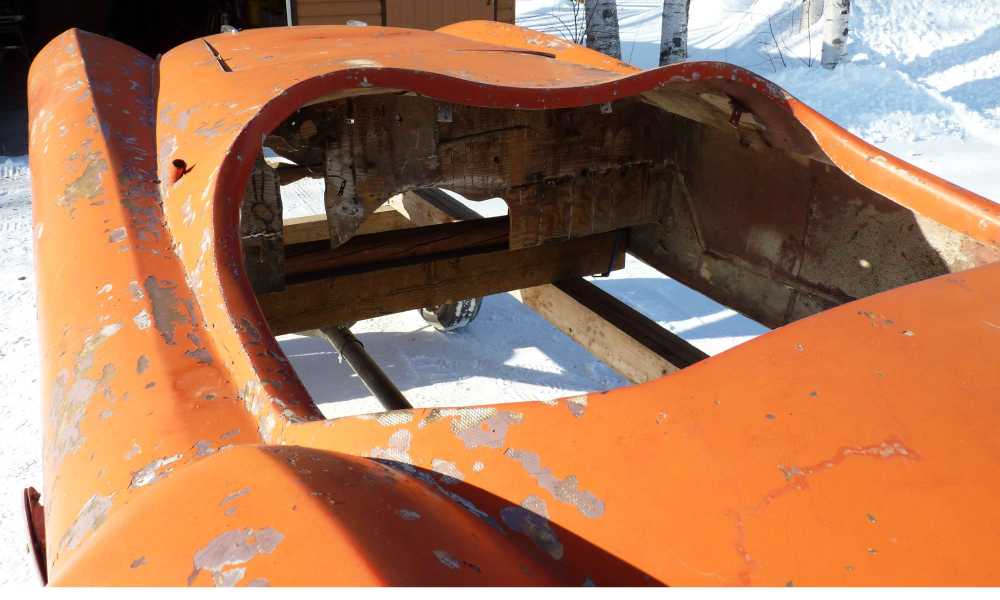
I was wondering when a little more research might be done that was not confined to the United States might be forthcoming. My contribution might be the possibility of the builder would be the Senna shops in Barcelona and it could have been a one off for a visiting Canadian serving military time in Europe as the U S did. After the deployment was concluded, the car may have been shipped to his home in Manitoba just like it was done for our soldiers. Life was a little sweeter then I think Lets hear from someone in Spain or Europe for some thoughts. See if I can be proven right or wrong. Either way we all win
Well, I did look it up and the front-end design is very close to the Lancia Augusta but not “identicle” as you say it is. The headlight openings on the Lancia are tapered to accommodate two different sized lamps. The mystery body would appear to support two lamps of the same size.
For those who didn’t try to find the SERRA bodied 1934/54 Lancia Augusta, the front of this car is identicle to the mystery Canadian body.
DID ANYONE LOOK UP THE 1934/54 LANCIA AGUSTA WITH THE BODY BY SERRA ON THE POST WAR CLASSICS SITE?
Re the mystery Canadian body. See if you can find the 1934/54 Lancia Augusta with body by Serra on the Post War classics site.
This one’s way too pretty to not get built. Somebody please step up to the plate. I really like it!
Rodney
What strikes me is it\’s color. These cars were often repainted of course, but this particular orange-reddish is very close to the color of my Glasspar G2. It spent some time in northern Ca in the 60\’s, and came with a Shnell intake manifold rumored to have been made in Washington state, and was definitly set up for racing. Could there have been team campaigning that identified itself with this unique and eye-catching color? Too bad it\’s only the body that survives.
In 1954 GHIA built a one off Dodge Granada concept car out of fibreglass.
I think this body may be more important than you all realize. It looks so professional. Being in Canada may mean nothing. May I suggest you contact GM Motorama cars collector Joe Bortz if he knows anything about it. It has a bit of a GHIA look.
Ditto all the comments above. Well thought-out design, by a talented person. If it had entered the component body market in the mid ’50s it would have done well.
Looks more like a first series Woodill with a knock off of an Exner / Dual-Ghis [circa 1957] design. More likely done after 1958. There is also a 1953 Ghia Cadillac that Rita Hayworth owned with the same basic frontal design. It was the first Ghia body with quad head-lights.
Also the tail-light holes look to be made for 1952 to 1954 Ford lights – much larger than the Pontiac lamps often used. A 1959 Buick unit would fit, too – more like LaDarwi.
Another taillight that would have been in keeping with this era of styling would be the 1949 Lincoln – a better choice than Ford assembly. The hole size looks right, too.
I agree with Bob, who ever designed this car took the greatest features of each fiberglass car , G2 body lines, the flares of the body leading up to the dash, Woodill style, this looks like a job done by an employee of Glasspar.
I wouldn’t mine seeing it in my driveway!
Quad headlights were standard on 1958 USA automobiles. The body has the look of some very sophicated lines here and there. The designer was not a beginner car guy. A well executed body.
What is the wheelbase and track?
I like the look and mid-fifties feel. To my eye the basic body shape looks like a Glasspar. Love to see that one on the road.
Nice looking car! To me, it has the flavor of an Arnolt Bristol which were built from 1953 – 68 by Bertone in Italy for S.H.’Wacky’ Arnolt.
Those are interesting step pockets in the doors, like something you’d see on an aircraft. Gary
GEOFF There is nothing like old fiberglass styling the ideas and creativeness back in those days always astounds me—-in todays world most fiberglass companies just make molds off of something someone else created —fresh ideas are hard to find —-thanks for all the articles —dennis kaz
~ Fascinating head-scratcher! Had I been the one to first find this piece of history, I would have done just as Ed A. & Mark E. have done; contact Geoff to access the larger pool of knowledge. I’m sure I am among many awaiting the next installment.